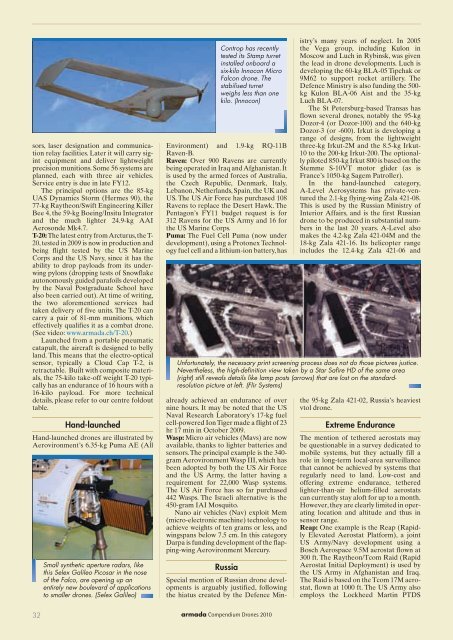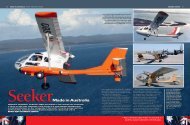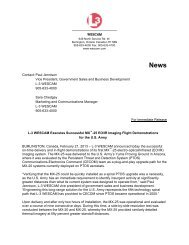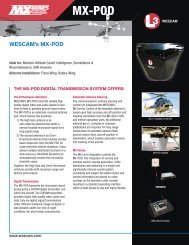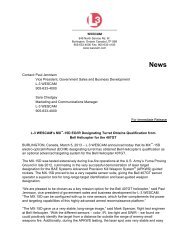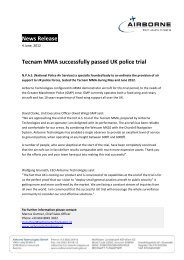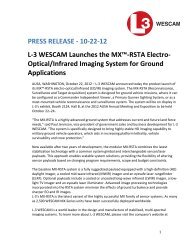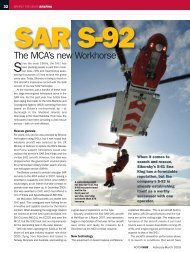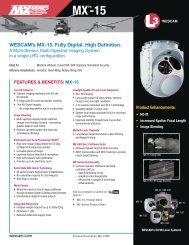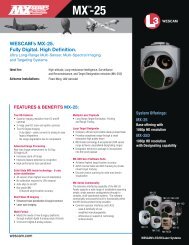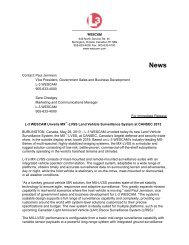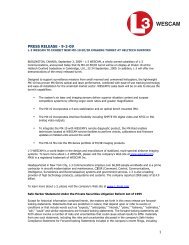Sensors - Wescam
Sensors - Wescam
Sensors - Wescam
You also want an ePaper? Increase the reach of your titles
YUMPU automatically turns print PDFs into web optimized ePapers that Google loves.
sors, laser designation and communication<br />
relay facilities. Later it will carry sigint<br />
equipment and deliver lightweight<br />
precision munitions. Some 56 systems are<br />
planned, each with three air vehicles.<br />
Service entry is due in late FY12.<br />
The principal options are the 85-kg<br />
UAS Dynamics Storm (Hermes 90), the<br />
77-kg Raytheon/Swift Engineering Killer<br />
Bee 4, the 59-kg Boeing/Insitu Integrator<br />
and the much lighter 24.9-kg AAI<br />
Aerosonde Mk4.7.<br />
T-20: The latest entry from Arcturus, the T-<br />
20, tested in 2009 is now in production and<br />
being flight tested by the US Marine<br />
Corps and the US Navy, since it has the<br />
ability to drop payloads from its underwing<br />
pylons (dropping tests of Snowflake<br />
autonomously guided parafoils developed<br />
by the Naval Postgraduate School have<br />
also been carried out). At time of writing,<br />
the two aforementioned services had<br />
taken delivery of five units. The T-20 can<br />
carry a pair of 81-mm munitions, which<br />
effectively qualifies it as a combat drone.<br />
(See video: www.armada.ch/T-20.)<br />
Launched from a portable pneumatic<br />
catapult, the aircraft is designed to belly<br />
land. This means that the electro-optical<br />
sensor, typically a Cloud Cap T-2, is<br />
retractable. Built with composite materials,<br />
the 75-kilo take-off weight T-20 typically<br />
has an endurance of 16 hours with a<br />
16-kilo payload. For more technical<br />
details, please refer to our centre foldout<br />
table.<br />
Hand-launched<br />
Hand-launched drones are illustrated by<br />
Aerovironment’s 6.35-kg Puma AE (All<br />
Small synthetic aperture radars, like<br />
this Selex Galileo Picosar in the nose<br />
of the Falco, are opening up an<br />
entirely new boulevard of applications<br />
to smaller drones. (Selex Galileo)<br />
Controp has recently<br />
tested its Stamp turret<br />
installed onboard a<br />
six-kilo Innocon Micro<br />
Falcon drone. The<br />
stabilised turret<br />
weighs less than one<br />
kilo. (Innocon)<br />
Environment) and 1.9-kg RQ-11B<br />
Raven-B.<br />
Raven: Over 900 Ravens are currently<br />
being operated in Iraq and Afghanistan. It<br />
is used by the armed forces of Australia,<br />
the Czech Republic, Denmark, Italy,<br />
Lebanon, Netherlands, Spain, the UK and<br />
US. The US Air Force has purchased 108<br />
Ravens to replace the Desert Hawk. The<br />
Pentagon’s FY11 budget request is for<br />
312 Ravens for the US Army and 16 for<br />
the US Marine Corps.<br />
Puma: The Fuel Cell Puma (now under<br />
development), using a Protonex Technology<br />
fuel cell and a lithium-ion battery, has<br />
istry’s many years of neglect. In 2005<br />
the Vega group, including Kulon in<br />
Moscow and Luch in Rybinsk, was given<br />
the lead in drone developments. Luch is<br />
developing the 60-kg BLA-05 Tipchak or<br />
9M62 to support rocket artillery. The<br />
Defence Ministry is also funding the 500-<br />
kg Kulon BLA-06 Aist and the 35-kg<br />
Luch BLA-07.<br />
The St Petersburg-based Transas has<br />
flown several drones, notably the 95-kg<br />
Dozor-4 (or Dozor-100) and the 640-kg<br />
Dozor-3 (or -600). Irkut is developing a<br />
range of designs, from the lightweight<br />
three-kg Irkut-2M and the 8.5-kg Irkut-<br />
10 to the 200-kg Irkut-200. The optionally<br />
piloted 850-kg Irkut 800 is based on the<br />
Stemme S-10VT motor glider (as is<br />
France’s 1050-kg Sagem Patroller).<br />
In the hand-launched category,<br />
A-Level Aerosystems has private-ventured<br />
the 2.1-kg flying-wing Zala 421-08.<br />
This is used by the Russian Ministry of<br />
Interior Affairs, and is the first Russian<br />
drone to be produced in substantial numbers<br />
in the last 20 years. A-Level also<br />
makes the 4.2-kg Zala 421-04M and the<br />
18-kg Zala 421-16. Its helicopter range<br />
includes the 12.4-kg Zala 421-06 and<br />
Unfortunately, the necessary print screening process does not do those pictures justice.<br />
Nevertheless, the high-definition view taken by a Star Safire HD of the same area<br />
(right) still reveals details like lamp posts (arrows) that are lost on the standardresolution<br />
picture at left. (Flir Systems)<br />
already achieved an endurance of over<br />
nine hours. It may be noted that the US<br />
Naval Research Laboratory’s 17-kg fuel<br />
cell-powered Ion Tiger made a flight of 23<br />
hr 17 min in October 2009.<br />
Wasp: Micro air vehicles (Mavs) are now<br />
available, thanks to lighter batteries and<br />
sensors. The principal example is the 340-<br />
gram Aerovironment Wasp III, which has<br />
been adopted by both the US Air Force<br />
and the US Army, the latter having a<br />
requirement for 22,000 Wasp systems.<br />
The US Air Force has so far purchased<br />
442 Wasps. The Israeli alternative is the<br />
450-gram IAI Mosquito.<br />
Nano air vehicles (Nav) exploit Mem<br />
(micro-electronic machine) technology to<br />
achieve weights of ten grams or less, and<br />
wingspans below 7.5 cm. In this category<br />
Darpa is funding development of the flapping-wing<br />
Aerovironment Mercury.<br />
Russia<br />
Special mention of Russian drone developments<br />
is arguably justified, following<br />
the hiatus created by the Defence Minthe<br />
95-kg Zala 421-02, Russia’s heaviest<br />
vtol drone.<br />
Extreme Endurance<br />
The mention of tethered aerostats may<br />
be questionable in a survey dedicated to<br />
mobile systems, but they actually fill a<br />
role in long-term local-area surveillance<br />
that cannot be achieved by systems that<br />
regularly need to land. Low-cost and<br />
offering extreme endurance, tethered<br />
lighter-than-air helium-filled aerostats<br />
can currently stay aloft for up to a month.<br />
However, they are clearly limited in operating<br />
location and altitude and thus in<br />
sensor range.<br />
Reap: One example is the Reap (Rapidly<br />
Elevated Aerostat Platform), a joint<br />
US Army/Navy development using a<br />
Bosch Aerospace 9.5M aerostat flown at<br />
300 ft. The Raytheon/Tcom Raid (Rapid<br />
Aerostat Initial Deployment) is used by<br />
the US Army in Afghanistan and Iraq.<br />
The Raid is based on the Tcom 17M aerostat,<br />
flown at 1000 ft. The US Army also<br />
employs the Lockheed Martin PTDS<br />
32 armada Compendium Drones 2010


